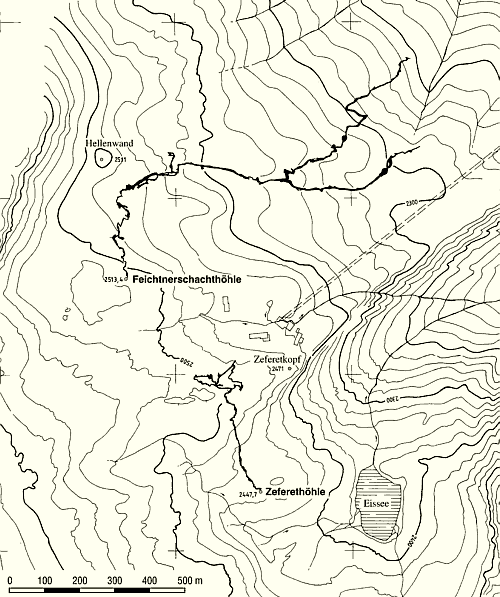The Kitzsteinhorn massif lies in the Hohe Tauren in the south of Austria.
The highest peak, with altitude of 3 208 m, gives its name to the whole
mountain group. Its upper part is covered with a glacier. The area is
mostly built of mica-bearing carbonate schists (Kalkglimmerschiefer) intercalating
with prasinites and phyllites. These rocks were deformed in the Alpine
orogeny. The calcareous chists consist of alternating light and dark (rich
in mica) layers which when seen in cross-section, have appearance of a
zebra skin. The rock strata, at the surface and in the caves, dip regularly
at ca 65° to the north.
The waters of the massif, traced with dying tests, emerge in the Kesselfall
resurgence (ca 1050 m above sea level) in the Kaprun Stream (Kapruner
Ache). Rainwater and meltwater from ice and snow descend about 1 500 m
of vertical distance between the feeding area and the resurgence.
The caves in this area are developed along tectonic fractures, fractures
related to rock schistosity and along intercalations rich in mica which
in aquatic environment transforms into clay minerals. The underground
cavities form by joint action of karst phenomena and gravitative flaking
off of the layer fragments. A dozen of caves were explored in the area.
The greatest of these is Feichtnerschachthöhle with its depth of 1 025
m and the length of ca 3 km. Observations suggest that the explored objects
are mostly of postglacial origin and are related to the successive phases
of the Schmiedinger Kees glacier retreat. The galleries formed in phreatic
zone, seen in Feichtnerschachthöhle may be a relic of the earlier phase
of the cave formation, related to a warm climate. Quartz druses found
at -400 m may suggest that thermal waters participated in the evolution
of the caves in this massif. The Kitzsteinhorn caves are richly decorated
with cave formations despite being situated at high altitude and close
to a glacier front. U-Th dating of the speleothems (Helena Hercman, unpublished)
has shown that the galleries in the Feichtnerschachthöhle near Ziklopengang
have been dry for 118 ka. Most known caves in the area are „living” objects,
shaped by present-day processes.
Exploration History
 |
|
photo: Jakub Nowak
|
Exploration of the Kitzsteinhorn caves has began in 1982 when we were
invited by Franz Meiberger to pay a visit to Kitzsteinhornhöhle (Zeferethöhle)
during our expedition to the Loferer Steinberge. The cave was then about
350 m deep. In one action we have then got to an impassable cleft at -502
m. The cave have fascinated us by being so different to anything we have
seen before. As a consequence, Krakowski Klub Taternictwa Jaskiniowego
has organised another expedition in winter 1983 during which, in other
series, they reached another narrow cleft at -560 m.
Co-operation with the Hydrology Division of Tauernkraftwerke AG was initiated
during this expedition. The firm owns the hydroengineering installations
and hydropower plants as well as the skiing facilities. Tauernkraftwerke
AG is also renting the whole area, owned by an Austrian family living
in Argentina. This makes getting a permission for exploration in the area
a quite complex issue. In our case this caused a 15-years break in exploration.
Meanwhile, a small team of Tauernkraftwerke AG workers, led by Richard
Feichtner and inspired by our discoveries, investigated other cave entrances.
The most interesting discovery was an entrance melted out within a perennial
snowfield at altitude of 2 510 m and leading to a spacious ramp. Its exploration,
begun in 1984 by Richard Feichtner occasionally supported by a team of
his friends, led at the depth of 520 m to the top of a shaft, dubbedGBK
Schachf. ![]()
